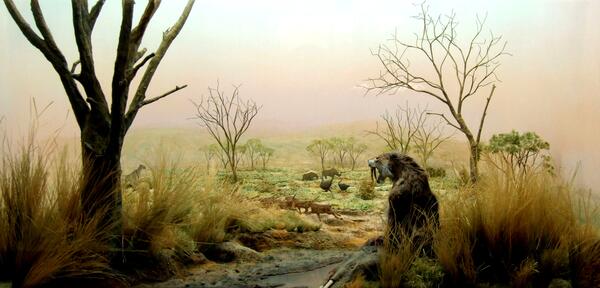This miniature diorama, entitled ‘The Neogene Savannah’, displays a section of the modern-day right bank of Saratov during the Neogene period of the Cenozoic era (approximately 25–1.8 million years ago). This period was marked by strong upward movements in the earth’s crust. The world’s highest mountain ranges rose up in the south: The Himalayas, Tian Shan, Caucasus, Pamir Mountains and Altai Mountains. A less extreme result of these movements of the earth’s crust were the Volga Uplands. This region today falls partly in the Saratov Right Bank. The future Saratov Left Bank also rose up, before falling back down at the end of the period and becoming covered by the waters of the Akchagyl and then later the Apsheronian basin. The latter’s warm waters were filled with carnivorous whales like archaeocetis, and the number of bivalve mollusks grew. The diorama depicts the Volga Uplands landscape, which was a flat savannah inhabited by a variety of mammals.
In the foreground there is a sabre-toothed cat with its prey, including a baby mastodon and an old elephant. Sabre-toothed cats existed on every continent - except Australia - from the end of the Paleogene era until the middle of the Anthropocene era. Sabre-toothed cats had long, powerful fangs, up to 20 centimeters in length. These animals were farther bigger than modern cats. They had powerful clawed paws and a powerful neck. Their forelimbs were longer and stronger than their hind legs. Their main prey were large herbivorous mammals such as rhinoceroses and mastodons. Judging by the composition of their body, sabre-toothed cats could not leap very far from their ambush position or chase prey for very long. It is likely that they foraged for food using their powerful fangs, which they also used to mortally wound their prey. One of the most common sabre-tooth cats where modern-day Europe stands today was the Machairodus — a sabre-toothed tiger. Its fangs, curved like a sabre, could be over fourteen centimeters long. Sabre-toothed cats became extinct around 11,000 years ago.
Mastodons appeared in Africa around 35 million years ago. They were similar to mammoths and modern-day elephants, reaching the same size, with the same five-toed limbs, tusks and trunks. They also lead a similar lifestyle. These animals became extinct around 10,000 years ago.
The background depicts the ancestors of many modern birds and animals, including ostriches, rhinoceroses, giraffes and horses.
In the foreground there is a sabre-toothed cat with its prey, including a baby mastodon and an old elephant. Sabre-toothed cats existed on every continent - except Australia - from the end of the Paleogene era until the middle of the Anthropocene era. Sabre-toothed cats had long, powerful fangs, up to 20 centimeters in length. These animals were farther bigger than modern cats. They had powerful clawed paws and a powerful neck. Their forelimbs were longer and stronger than their hind legs. Their main prey were large herbivorous mammals such as rhinoceroses and mastodons. Judging by the composition of their body, sabre-toothed cats could not leap very far from their ambush position or chase prey for very long. It is likely that they foraged for food using their powerful fangs, which they also used to mortally wound their prey. One of the most common sabre-tooth cats where modern-day Europe stands today was the Machairodus — a sabre-toothed tiger. Its fangs, curved like a sabre, could be over fourteen centimeters long. Sabre-toothed cats became extinct around 11,000 years ago.
Mastodons appeared in Africa around 35 million years ago. They were similar to mammoths and modern-day elephants, reaching the same size, with the same five-toed limbs, tusks and trunks. They also lead a similar lifestyle. These animals became extinct around 10,000 years ago.
The background depicts the ancestors of many modern birds and animals, including ostriches, rhinoceroses, giraffes and horses.






